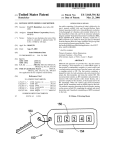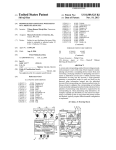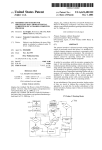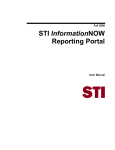Download Backup pin entry using camera and ocr
Transcript
US 20100081414A1
(19) United States
(12) Patent Application Publication (10) Pub. No.: US 2010/0081414 A1
(43) Pub. Date:
Poisner
(54)
BACKUP PIN ENTRY USING CAMERA AND
OCR
(76) Inventor:
Apr. 1, 2010
Publication Classi?cation
(51)
Int. Cl.
H04M 1/66
(2006.01)
455/411
David Poisner, Carmichael, CA
(Us)
(57)
ABSTRACT
A personal identi?cation number (PIN) may be used as a
Correspondence Address:
INTEL CORPORATION
basic security measure to unlock an electronic device. PINs
are notoriously forgotten or unavailable. A_ma_ster _secur1ty
do CPA Global
master security code may comprise printed indicia such as an
P-O- BOX 52050
MINNEAPOLIS, MN 55402 (Us)
alpha-numeric text string, for example, printed in the device
oWner’s manual. Apicture or image of the page containing the
code may be used to unlock the devlce 1n this s1tuat1on. The
master security code may be snapped With a built-in camera
(21) App1.No.:
(22) Filed:
12/242,718
feature. Optical character recognition (OCR) may be used to
extract the master security code text string from the image and
Sep. 30, 2008
compared to a like master security code stored in the device.
If they match, the device may be unlocked even Without the
PIN.
Patent Application Publication
Apr. 1, 2010 Sheet 1 0f 2
US 2010/0081414 A1
Patent Application Publication
Apr. 1, 2010 Sheet 2 0f 2
US 2010/0081414 A1
100
264
L:
vi 3 ii“;
290
{I an“;
/—— 108
Fig. 2
Apr. 1,2010
US 2010/0081414 A1
BACKUP PIN ENTRY USING CAMERA AND
OCR
With the embodiment is included in at least one embodiment
of the present invention. Thus, the appearances of the phrases
“in one embodiment” or “in an embodiment” in various
FIELD OF THE INVENTION
[0001] Embodiments of the present invention are directed
electronic device security and, more particularly, to unlock
ing an electronic device if the password is forgotten or
unknown.
BACKGROUND INFORMATION
[0002] Wireless devices, such as cellular telephones, and
Personal Digital Assistants (PDA) communicators are gain
ing Widespread acceptance. In order to be competitive in the
marketplace and to meet consumer demand, service providers
places throughout this speci?cation are not necessarily all
referring to the same embodiment. Furthermore, the particu
lar features, structures, or characteristics may be combined in
any suitable manner in one or more embodiments.
[0010]
As discussed above, hand held PDAs for general
purpose communication and data storage are popular. More
recently, speci?c purpose portable devices have been devel
oped. In particular, in the healthcare ?eld a hand held device
may provide a variety of functions, including a device for the
sight impaired Which can read text aloud. In short, the device
uses a built-in camera to take pictures of text, perform an
continue to offer an ever expanding array of services and
optical character recognition (OCR) on the text, and then uses
text-speech synthesis to read it out loud to the user. This
features. Current generations of PDAs incorporate many fea
tures including cellular phone service.
[0003] PDAs are hand-held computers originally designed
device is not only advantageous for the sight impaired, but
also for the elderly Which may have trouble reading smaller
for use as personal organizers for storing notes, contact infor
mation, calendar dates and so forth. The current generation of
PDAs additionally incorporate Wireless and cellular technol
ogy and act as a phone for voice communications as Well as
alloWs users to access a variety of information and include
services and features such as internet broWsing, access to
driving directions, instant stock quotes, global positioning
system (GPS) capabilities, entertainment locators, email ser
vice, cameras, and a variety of multimedia and video capa
bilities, to name a feW.
[0004]
Many of these hand-held devices also incorporate a
certain level of security to protect against unWanted users as
Well as to protect the privacy of the personal data stored
therein. One of the most common and Well knoWn security
measures is a passWord or personal identi?cation number
(PIN). In a locked mode, an authorized user must enter the
PIN to unlock the device and enable the features. HoWever, if
the PIN is forgotten or lost, even the oWner or other authorized
user cannot use the device.
BRIEF DESCRIPTION OF THE DRAWINGS
[0005] The foregoing and a better understanding of the
present invention may become apparent from the folloWing
detailed description of arrangements and example embodi
texts.
[0011] In addition, a user may have private information
stored on the device. Such private information may include
such things as scans of credit card receipts, tax forms, medical
records, or business transactions. The device includes a PIN
based method to protect access to the user’s data ?les. If the
correct PIN is not entered, the system prevents the reading,
deletion, modi?cation, or renaming of the user’s ?les.
[0012] There are some cases Where the user may forget the
PIN, or the user is no longer available to enter the PIN, such
as if they die or leave employment, in the case Where the
device is oWned by an employer.
[0013] In some systems, the PIN can be bypassed by having
a secondary PIN. This secondary PIN might be something
other than a passWord, such as a series of questions that
contain information that presumably Would only be knoWn to
the user. For example, this might include questions about
favorite colors, school mascots, parents, etc.
[0014] HoWever, entry of these types of questions may be
dif?cult since the device may not have a traditional keyboard.
Furthermore, these types of schemes are inherently poor in
the long term because the private information may be needed
for multiple systems, and compromise of one could result in
compromise of other systems.
[0015]
Embodiments of the present invention provide a
ments and the claims When read in connection With the
system to unlock or override the PIN security With a master
accompanying draWings, all forming a part of the disclosure
of this invention. While the foregoing and folloWing Written
security code or key using the natural interface and capabili
ties of the device Without actually manually entering a code.
and illustrated disclosure focuses on disclosing arrangements
and example embodiments of the invention, it should be
clearly understood that the same is by Way of illustration and
example only and the invention is not limited thereto.
Embodiments may comprise a Wide array of electronic
[0006]
FIG. 1 is a hand held device including a camera
feature according to one embodiment of the invention; and
[0007] FIG. 2 is a block diagram ofthe basic components of
the of the hand held device.
DETAILED DESCRIPTION
[0008] Described is an apparatus and method to alloW an
authorized user to override the security features of an elec
devices including cell phones, Ultra Mobile Devices, or
PDAs that are equipped With a camera.
[0016] Referring noW to FIG. 15 there is shoWn an exem
plary electronic device, such as a PDA 100. The device may
alloW services such as phone for voice communications as
Well as alloWs users to access a variety of information and
include services and features such as internet broWsing, glo
bal positioning system (GPS) capabilities, email service,
store music and data, etc. Typically, the electronic device 100
is of a size and Weight Which easily ?ts in a user’s hand. The
device 100 may have a display screen 102 With Which to
access to the master code.
display text and graphics. The display screen 102 may also be
a touch type display screen alloWing the user to input data and
commands by touching the screen With their ?nger or With a
[0009]
stylus (not shoWn).
tronic device With a master code. Security is maintained,
hoWever, since only an authorized user may have physical
Reference throughout this speci?cation to “one
embodiment” or “an embodiment” means that a particular
feature, structure, or characteristic described in connection
[0017] A keypad 104 may be included as Well to alloW the
user to input data and commands. The keypad 104 may be a
Apr. 1,2010
US 2010/0081414 A1
full alpha-numeric keypad or may just comprise one or more
special function keys as shown. In the case Where the display
screen 102 is a touch-type screen, the keypad 104 may option
ally be omitted. In addition, a cursor control 106 may also be
tion Which may be a virtual button on the display screen 102
or pressing a selected button on the keypad 104.
included to alloW a user to perform mouse-type cursor move
ments.
tion on the last picture taken. It Will then compare With the
comparator module 200 the output of the OCR module 202
With a copy of the master security code 204 stored in the
device 100. If the string compares, then the system Will treat
this as the equivalent of the PIN and the device Will unlock.
[0025] According to embodiments a backup PIN or master
security code is stored as a text string that may be extracted
[0018] A camera 108 is also included to alloW the electronic
device to capture and store images. The camera 108 is shoWn
on the front of the electronic device 100 for purposes of
illustration, but the camera 108 may be located anyWhere.
The device 100 may also include a speaker and microphone
such a traditional phone Would have as Well as speaker-phone
[0024]
When the unlock function is selected, the device 100
Will perform an optical character recognition (OCR) opera
using OCR operation. Since many hand held devices already
capabilities allowing the user to hear and talk Without having
include cameras, there may be no additional hardWare cost to
to hold the device 100 to their head.
[0019] As noted above, the device 100 may include a secu
rity function that alloWs the user to optionally select a per
unavailable, there is no need for the user to remember any
sonal identi?cation code (PIN) of their choice Which is used
to lock the functions of the device from use as Well as lock any
data stored therein. The PIN may be an alpha-numeric string
of characters chosen at random by the user; preferably some
thing easy to remember but dif?cult for someone else to ?gure
out. The PIN may be enter in a variety of Ways by the user,
such as by typing on the display screen 102 or on the keypad
104 or perhaps even by speaking it (out of earshot of others)
if the device 100 has speech recognition capabilities.
[0020] Unfortunately, often times PINs are forgotten or
changed often and the neW PIN forgotten, or the authorized
user that selected the PIN is no longer available, such as in the
case of death or disability or if the PIN is biometric. Accord
ing to embodiments, the device 100 includes a “master secu
rity code” 110 or key Which can alWays unlock the device
Without need of the current PIN. This master code 110 may be
an alpha-numeric string Which is suf?ciently long and ran
dom. In other embodiments, the master code may be symbols
or, for example, a bar code. The master code 110 may be
speci?c that that particular device 100 and may be shipped
With the device 100 as printed indicia and may be printed, for
example, in the oWner’s manual 112 for the device 100. The
manual 112, and thus the master code 110 along With it, may
be stored in a safe place apart from the device 100.
[0021] In operation, should the PIN be unknoWn, the user
may retrieve the master code 112 from its secure location, and
use the camera 108 feature of the device to capture the image
of the master code 110. Thereafter, the device 100 may use
optical character recognition (OCR) to convert the image into
text and compare the converted text to the master code stored
implement this type of security. Plus, should the PIN be
thing other than Where they last placed the unlock paper,
Which Will likely be With the rest of the user documentation
and user’s manual for the device.
[0026] The above description of illustrated embodiments of
the invention, including What is described in the Abstract, is
not intended to be exhaustive or to limit the invention to the
precise forms disclosed. While speci?c embodiments of, and
examples for, the invention are described herein for illustra
tive purposes, various equivalent modi?cations are possible
Within the scope of the invention, as those skilled in the
relevant art Will recogniZe.
[0027]
These modi?cations can be made to the invention in
light of the above detailed description. The terms used in the
folloWing claims should not be construed to limit the inven
tion to the speci?c embodiments disclosed in the speci?cation
and the claims. Rather, the scope of the invention is to be
determined entirely by the folloWing claims, Which are to be
construed in accordance With established doctrines of claim
interpretation.
What is claimed is:
1. An electronic device, comprising:
a master security code stored in the device;
a camera to capture an image of printed text,
an optical character recognition (OCR) module to extract
the text from the captured image; and
a comparator module to compare the text to the master
security code, Wherein the electronic device is unlocked
if the text matches the master security code.
2. The electronic device as recited in claim 1, further com
prising:
in the device. If they match, the device is unlocked and full
a touch-type display screen for inputting data.
operation is available to the user. Note, that even When the
device is locked, the camera feature remains available for the
3. The electronic device as recited in claim 1, Wherein the
electronic device comprises a personal digital assistant
purpose of this operation.
(PDA).
[0022] Referring noW to FIGS. 1 and 2, there is shoWn a
block diagram of the basic features of the device 100. At the
electronic device comprises a mobile telephone.
time of shipment, a unique unlock key or master security code
204 is programmed into the device 100. This key should be
suf?ciently long to make guessing unlikely. For example, this
4. The electronic device as recited in claim 1, Wherein the
5. The electronic device as recited in claim 1 Wherein the
electronic device comprises a personal identi?cation number
(PIN) security feature that is overridden by the master secu
could be a 32-digit alpha-numeric string. This string may also
rity code.
be printed on a piece of paper that is shipped With the device
100. That piece of paper might be the last page of the user
manual.
[0023] If the device 100 is “locked” via the PIN, and the
6. The electronic device as recited in claim 1, Wherein the
printed text comprises a paper having a copy of the master
user doesn’t knoW the pin, the user Will instead capture an
image of the “unlock” piece of the master security code 110
paper using standard image capture capability With the cam
era feature 108. The user may then select an “unlock” func
security code printed thereon.
7. A method for unlocking a locked electronic device,
comprising:
storing a master security code in the device;
taking a picture of a printed master security code With a
built-in camera;
Apr. 1,2010
US 2010/0081414 A1
extracting an alpha-numeric text string from the picture
using optical character recognition (OCR);
comparing the extracted alpha-numeric text string With the
master security code stored in the device; and
unlocking the electronic device if there is a match.
8. The method as recited in claim 7, Wherein the printed
master security code is printed on a piece of paper.
9. The method as recited in claim 8, Wherein the paper is
included With the user’s manual for the electronic device.
10. The method as recited in claim 8, Wherein the electronic
device comprises a personal digital assistant (PDA).
11. The method as recited in claim 8, Wherein the electronic
device comprises a mobile telephone.
12. The method as recited in claim 8 Wherein the device
comprises a device for storing personal data.
13. A system for unlocking a locked electronic device,
comprising:
a printed text separate from the electronic device;
a master security code stored in the device;
a camera to capture an image of the printed text;
an optical character recognition (OCR) module to extract
the text from the captured image; and
a comparator module to compare the text to the master
security code, Wherein the electronic device is unlocked
if the text matches the master security code.
14. The system as recited in claim 13, further comprising:
a touch-type display screen for inputting data.
15. The system as recited in claim 13, Wherein the elec
tronic device comprises a personal digital assistant (PDA).
16. The system as recited in claim 13, Wherein the elec
tronic device comprises a mobile telephone.
17. The system as recited in claim 13, Wherein the elec
tronic device comprises a personal identi?cation number
(PIN) security feature that is overridden by the master secu
rity code.
18. The system as recited in claim 13, Wherein the printed
text comprises a paper having a copy of the master security
code printed thereon.
19. The system as recited in claim 18, Wherein the paper
comprises the user’s manual for the electronic device.
*
*
*
*
*












